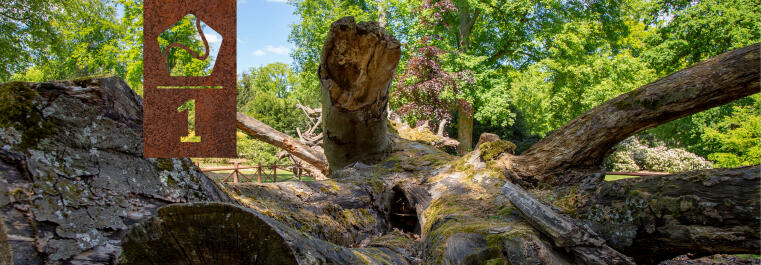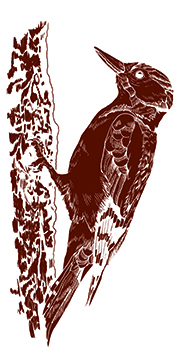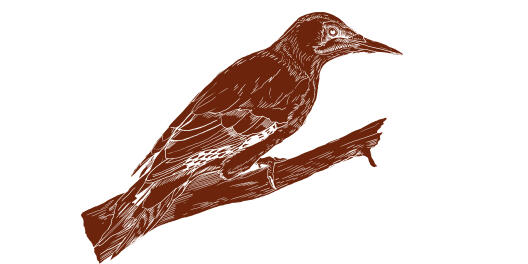

WOODPECKERS
There are two species of woodpecker to be seen in the garden: the great spotted woodpecker and the European green woodpecker. If you look through the sight tube at the stop you can see on the trees opposite the cavities they have made into their homes.

The great spotted woodpecker
- Is the most common species of woodpecker found in Germany
- Is 22 to 23 centimetres in size, about as big as a blackbird
- Has bright black, white and red feathers. The male differs from the female in having a red patch on its nape
- Feeds mainly on insects and their larvae, which it retrieves from under the bark of trees. Its diet also includes nuts, berries and seeds
- Its most common call – a short, loud “kik” – can be heard all year round

The European green woodpecker
- Is distinguished by its red crown and green coat
- Is between 30 and 36 centimetres in size
- Most of the time, you can see it on the ground, where it tirelessly seeks out its favourite food: Ants
- It has the longest tongue of all the woodpeckers and is able to stick it out to a length of up to ten centimetres
- Its characteristic call of “kyü-kyü-kyück” resembles human laughter
Drumming – the woodpeckers’ language
If you listen carefully in spring, when the weather’s fine, you can hear woodpeckers’ drumrolls in the garden here. These correspond to the singing sound made by other birds – in other words, woodpeckers communicate with one another by drumming. They use it to mark off their territory or to attract a mate. Different species of woodpecker have different drumrolls all their own. The drumrolls differ in their rhythm and their length, as well as in the length of the gap between the beats in a roll. A drumroll in the greater spotted woodpecker lasts for about two seconds and consists of 10 to 16 beats. Quite a feat, Woody Woodpecker!
Nest-building
To build their nests, woodpeckers mostly look for weakened trees in which the bark or trunk is damaged – for example as a result of storms or frost. Then they use their powerful beaks to make a hole in the trunk, removing the wood, layer by layer. Woodpeckers don’t spend all day building their nests, just for a few hours at a time – and the male and the female take it in turns. After the bird has been working for a while, it takes a beakful of chips and throws them aside. Gradually, the hole becomes bigger until finally it is deep enough for the woodpecker to disappear into the nest completely.
Physical characteristics
For building their nests, woodpeckers have the tools they need on their bodies: For chipping away the wood they use their strong, pointed beak. And in other ways, too, they are perfectly adapted to their habitat. The tongue is long and worm-like to enable the woodpecker to find and catch insects under the bark of trees or in crevices in the wood. The bird’s zygodactyl feet, together with the strong stiffened tail, provide support and safety on tree trunks.

WHAT'S THE ANSWER?
1. Woodpeckers create an important habitat for other animals which use trees. Which animals do you think these might be?
2. How long is the incubation period for greater spotted woodpeckers? And when do the young birds leave the nest?
3. Why doesn’t a woodpecker get headaches?
SOLVING:
1. There is a range of animals which benefit from using the nests abandoned by woodpeckers, converting them into nests of their own. These include tits, nuthatches, pigeons and jackdaws, as well as bats, hornets, squirrels and dormice.
2. As a rule, the greater spotted woodpecker lays between five and seven eggs which hatch after ten to twelve days. The young birds leave the nest after 20 to 23 days but continue to be fed for a further eight to ten days.
3. Good question! To prevent headaches, there is a shock-absorbing connection between the beak and the cranium. Also, the woodpecker’s cranium is more developed than in other birds, and so prolonged hammering is not a problem.

